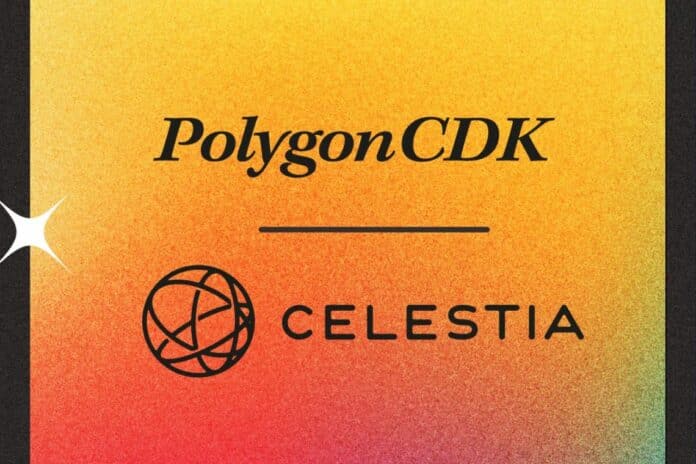Latest crypto news: Celestia has recently successfully implemented its modular data availability platform on Polygon CDK, representing a significant milestone.
This integration provides projects using Polygon CDK with a specialized solution for data access, ensuring a promising future for zk-based Layer 2 chain apps and reducing gas fees by 100%.
Let’s see below all the details.
Summary
Crypto news: Celestia offers a dedicated solution for data availability on Polygon CDK
As previously announced, the Celestia Foundation recently announced that Celestia will be integrated into the Chain Development Kit (CDK) by Polygon Labs.
This represents an open-source code base for launching L2 chains based on zero-knowledge proofs, offering unlimited scalability and unified liquidity.
We remind you that Celestia is the pioneering modular data availability (DA) network in the sector, capable of reducing Ethereum L2 transaction fees by over 100 times.
This partnership marks a significant step forward for Polygon’s CDK, providing projects with the opportunity to adopt a specific solution for data availability.
This allows users to ensure the security of their zk-based layer-2 application chains in response to a growing future demand.
The Polygon CDK will now be able to offer a 100% reduction in already low gas fees, ensuring lasting reliability and scalability to projects using it, including OKX, Immutable, Astar, Gnosis, Nubank, and many others currently in development.
The integration of Celestia into Polygon’s CDK represents a milestone in the industry, combining Celestia’s modular data availability with the Zero-Knowledge rollup technology developed by Polygon Labs.
This synergy embodies a massive paradigm shift in blockchain development, similar to the transition from dial-up connection to broadband, as stated by Sandeep Nailwal, co-founder of Polygon.
Celestia revolution: beyond the limits of L2 scaling and news in the Polygon ecosystem
Currently, L2 scaling solutions have limitations in their ability to increase throughput and reduce transaction fees on Layer-1 blockchains like Ethereum.
This is mainly due to DA-based rollups, which require all the data necessary to verify a block to always be available to all participants in the network.
Celestia, on the other hand, is a minimal blockchain that orders and publishes transactions without directly executing them, allowing for a separation between the consensus and execution layers of applications.
Celestia uses Data Availability Sampling (DAS) to verify DA without overloading individual nodes, reducing reliance on full nodes that need to download and query all blockchain data.
The integration of Celestia’s DA layer into Polygon’s CDK is a significant step that will allow Ethereum L2 developers to create Web2-like experiences on a fully Web3 infrastructure.
As Celestia’s adoption grows over time, its ability to scale securely, thanks to DAS, will allow any user of a CDK-based chain to contribute by running a Celestia light node.
This will further democratize the Polygon ecosystem, making it more accessible for developers to implement high-performance L2 on Ethereum, leveraging unified liquidity access and ensuring interoperability through a universal interoperability bridge.
Polygon redefines the user experience: the new developers portal
Recently, the layer-2 scaling protocol based on Ethereum, Polygon (MATIC), has recently abandoned its proprietary Wallet Suite in favor of the brand new Polygon Portal.
This innovative platform offers users and developers optimized access to a wide range of solutions related to the Polygon chain.
Through the Polygon Portal, users can explore complete dashboards dedicated to Polygon PoS, Polygon zkEVM, and Ethereum.
Among the advantageous features of this new portal, the Unified UX for bridging stands out, as well as the integration of third-party bridges, the possibility of gas supply, and the ease of access to development tools.
The Polygon Portal is equipped with complete documentation, offering users dedicated support and the ability to provide feedback.
Polygon continues to demonstrate its agility and adaptability, highlighted by its ability to constantly renew its solutions to make them more user-friendly for both developers and end users.
This progress in design has solidified Polygon’s position as the main destination for numerous companies and organizations entering the Web3 ecosystem.
In fact, as recent developments testify, even the global governing body of football, FIFA, has transferred its collections of non-fungible tokens (NFTs) from the Algorand blockchain to Polygon.
This move is part of a series of similar choices made by other major companies, such as Starbucks and Flipkart, who have activated loyalty programs on Polygon.




